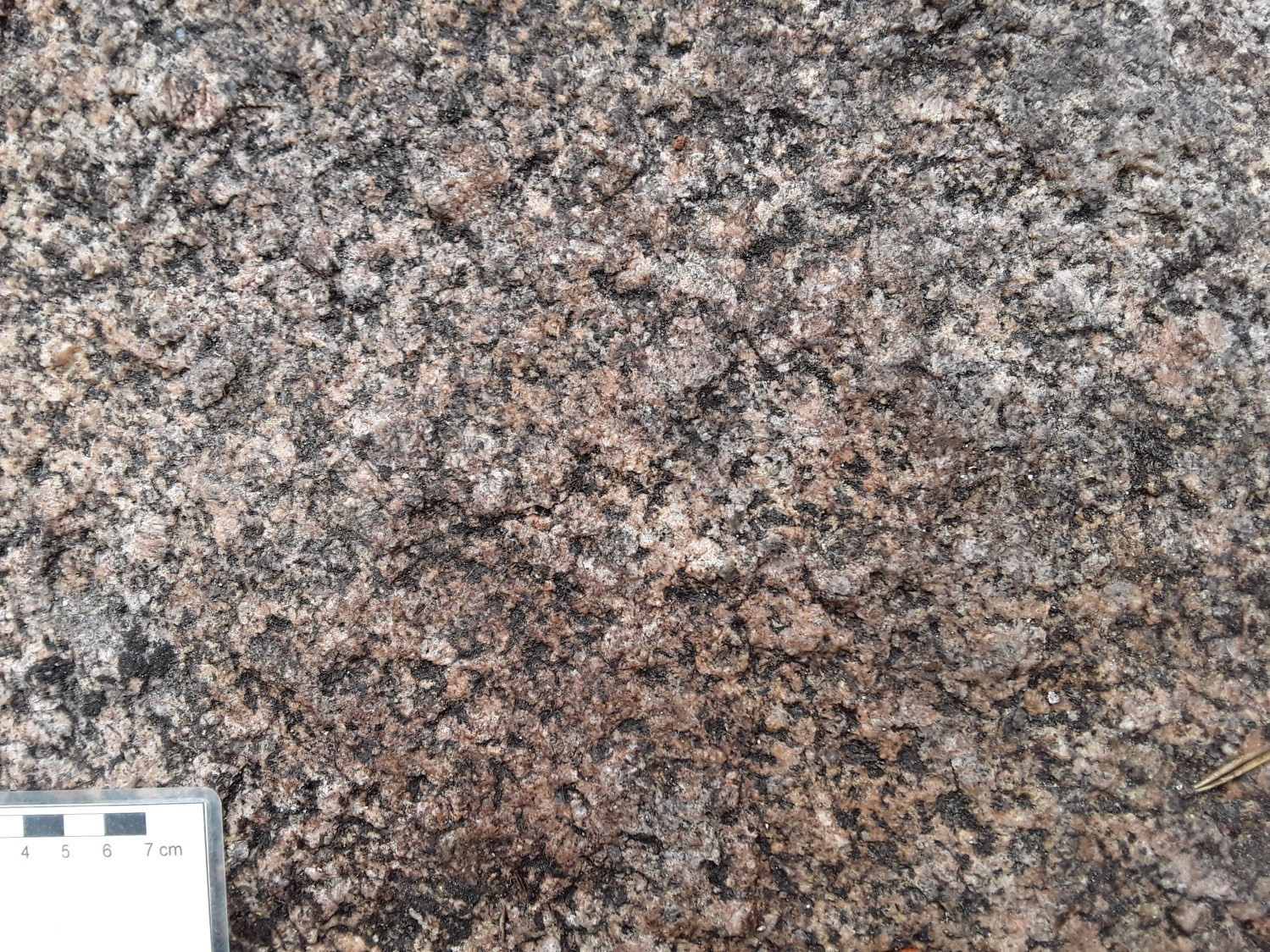
First published: 4 October 2022
Last modified:
DISCLAIMER: This English version is translated from the original French. In case of any discrepancy, the French version shall prevail.
None
| Author(s): | El Bourki and Moukhsil, 2021 |
| Age: | Mesoproterozoic |
| Stratotype: | Reference outcrop 2021-ME-1074 |
| Type area: | Area south of Long Lake (NTS sheet 32H07) |
| Geological province: | Grenville Province |
| Geological subdivision: | Allochton |
| Lithology: | Felsic, intermediate and mafic plutonic rocks |
| Category: | Lithodemic |
| Rank: | Lithodeme |
| Status: | Formal |
| Use: | Active |
-
None
-
Background
The Long Batholith was defined during mapping work by El Bourki and Moukhsil (2021) in the areas north of Dolbeau-Mistassini (sheet 32H01), Girardville and Lac Blondelas (sheet 32H07), in the Saguenay–Lac-Saint-Jean region. The name refers to Long Lake (sheet 32H07).
Description
The Long Batholith (mPlog) is a polyphase intrusion defined south of its eponymous lake (SE corner of sheet 32H07). The batholith is characterized by an intense magnetic susceptibility with a more or less elliptical shape. It was delineated following an interpretation of the aeromagnetic map of sheets 32H07 and 32H08 (Intissar and Benahmed, 2015). It consists of alkali feldspar granite, mangerite, quartz syenite, hypersthene syenite, gabbronorite and lesser proportions of syenogranite, quartz monzodiorite and granodiorite.

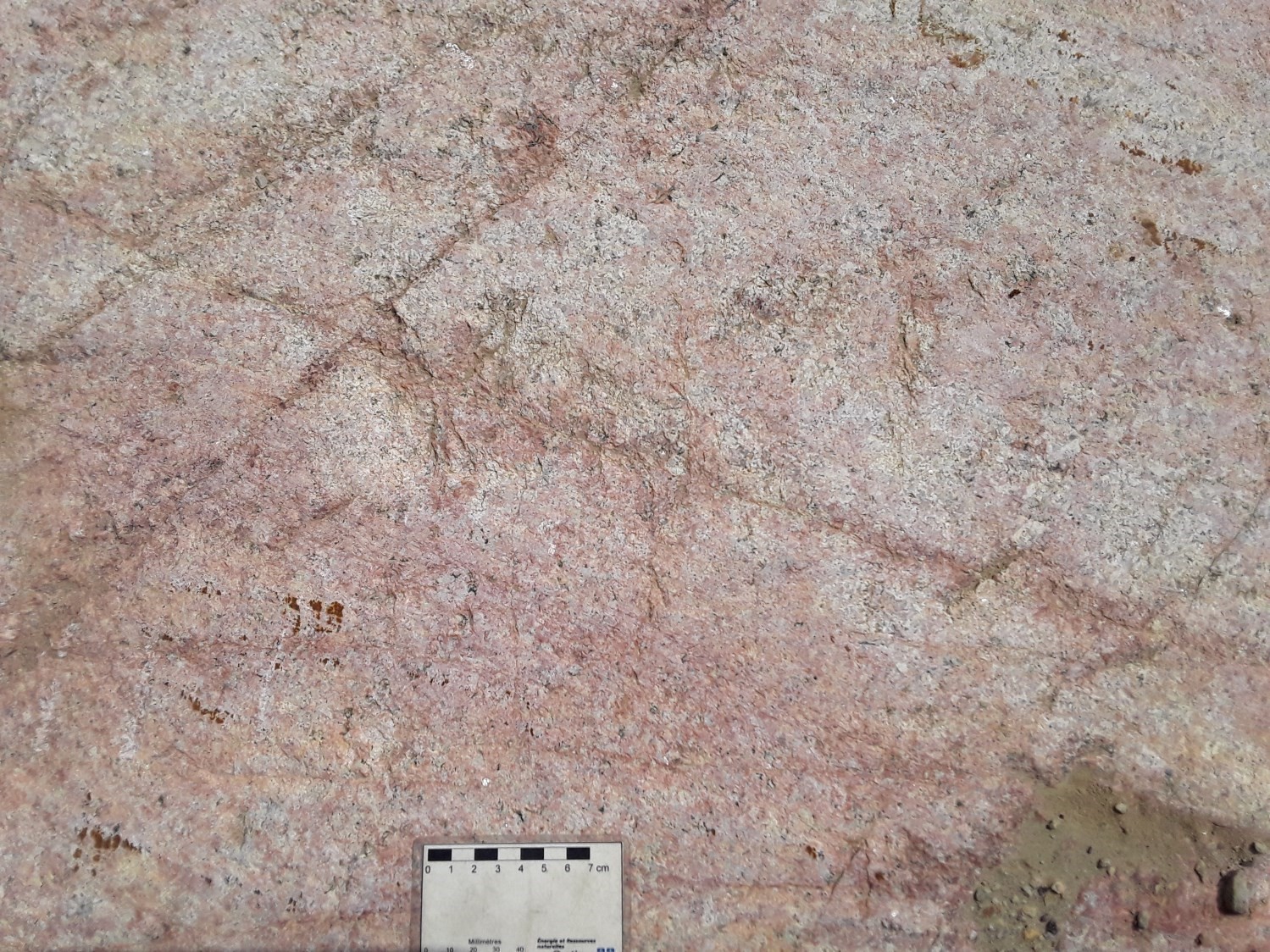 Alkali feldspar granite (e.g. outcrop 2021-FT-3309) is generally pink in alteration patina, brown-pink in fresh surface, medium to coarse grained and undeformed. It contains quartz, potassium feldspar, plagioclase, magnetite and variable proportions of biotite and hornblende from one outcrop to another. Hematization is observed on some outcrops and the rock is rather pinkish in alteration patina. This alteration is not very deep and only occupies the first few centimetres on the surface of the rock. In several outcrops, alkali feldspar granite is associated with gabbronorite. The contact between the two is sometimes very clear, but locally it can be diffuse.
Alkali feldspar granite (e.g. outcrop 2021-FT-3309) is generally pink in alteration patina, brown-pink in fresh surface, medium to coarse grained and undeformed. It contains quartz, potassium feldspar, plagioclase, magnetite and variable proportions of biotite and hornblende from one outcrop to another. Hematization is observed on some outcrops and the rock is rather pinkish in alteration patina. This alteration is not very deep and only occupies the first few centimetres on the surface of the rock. In several outcrops, alkali feldspar granite is associated with gabbronorite. The contact between the two is sometimes very clear, but locally it can be diffuse.

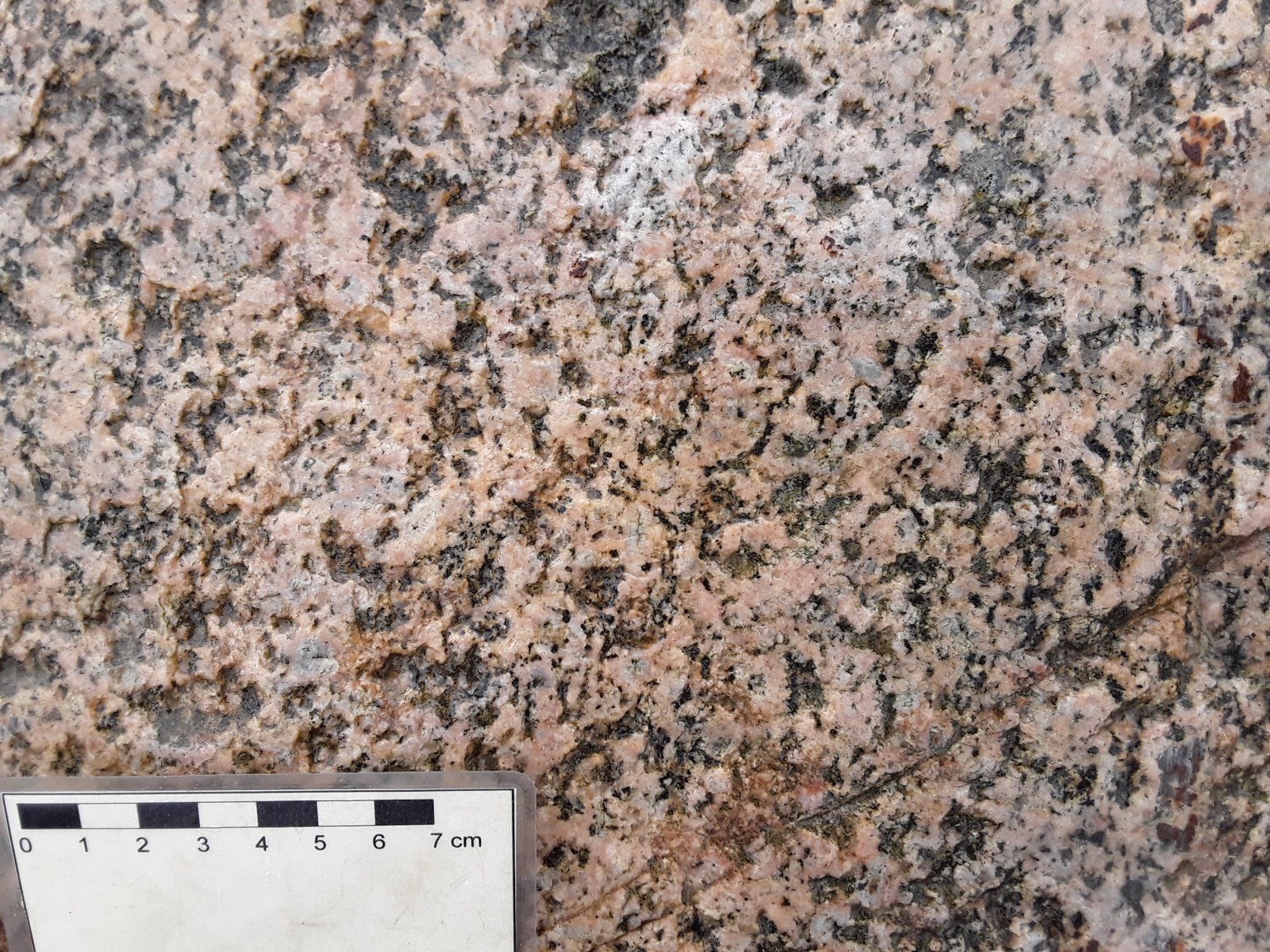 Mangerite (hypersthene monzonite), quartz syenite and hypersthene syenite can form an assemblage on the same outcrop. This is due to the variation in potassium feldspar and plagioclase content from one lithology to another. The mangerite is pink-brown in alteration patina, pink-grey in fresh surface, medium to coarse grained and generally foliated (e.g. outcrop 2021-FT-3094). Locally, the mangerite may be porphyroid to porphyroclastic with potassium feldspar phenocrysts (e.g. outcrop 2021-ME-1074). It contains orthopyroxene, plagioclase, quartz, hornblende, biotite and magnetite. Microscopically, potassium feldspar, especially microcline, is perthitic and ferromagnesian minerals (biotite, orthopyroxene, green hornblende) are grouped in millimetric clusters with magnetite. Large patches of undulatory extinction quartz and myrmekite are locally present. Allanite, apatite and zircon are the accessory phases of the mangerite. Quartz syenite and hypersthene syenite have the same structure as mangerite, but the differences lie in their specific mineralogical content, especially in the proportions of potassium feldspar and plagioclase.
Mangerite (hypersthene monzonite), quartz syenite and hypersthene syenite can form an assemblage on the same outcrop. This is due to the variation in potassium feldspar and plagioclase content from one lithology to another. The mangerite is pink-brown in alteration patina, pink-grey in fresh surface, medium to coarse grained and generally foliated (e.g. outcrop 2021-FT-3094). Locally, the mangerite may be porphyroid to porphyroclastic with potassium feldspar phenocrysts (e.g. outcrop 2021-ME-1074). It contains orthopyroxene, plagioclase, quartz, hornblende, biotite and magnetite. Microscopically, potassium feldspar, especially microcline, is perthitic and ferromagnesian minerals (biotite, orthopyroxene, green hornblende) are grouped in millimetric clusters with magnetite. Large patches of undulatory extinction quartz and myrmekite are locally present. Allanite, apatite and zircon are the accessory phases of the mangerite. Quartz syenite and hypersthene syenite have the same structure as mangerite, but the differences lie in their specific mineralogical content, especially in the proportions of potassium feldspar and plagioclase.
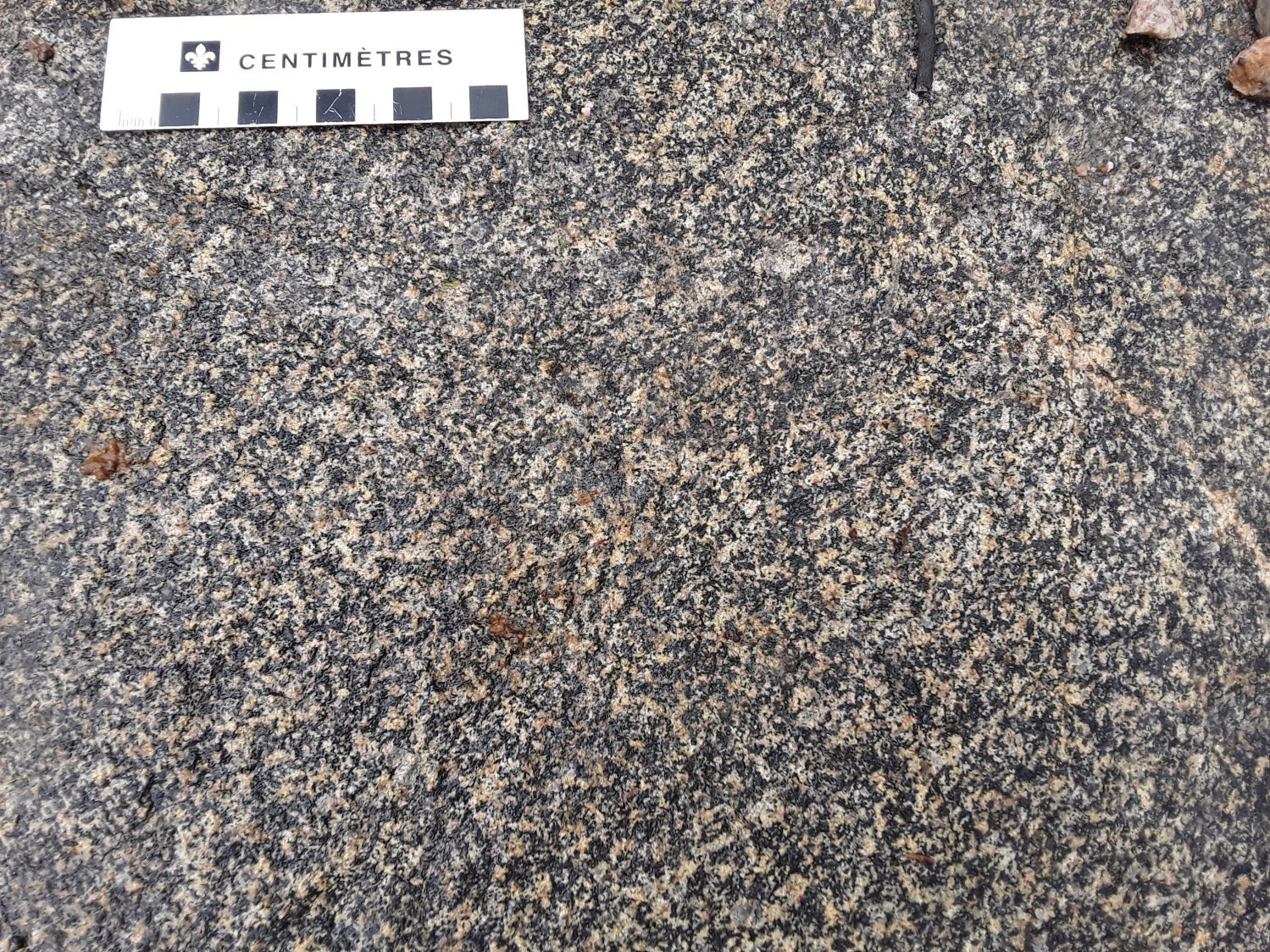 Gabbronorite is grey-brown in alteration patina, greyish in fresh surface, equigranular, fine to medium grained, with a subophitic structure (salt and pepper) and foliated (e.g. outcrop 2021-ME-1077). It consists of plagioclase, orthopyroxene and clinopyroxene as well as biotite and magnetite. Some outcrops show biotitization (e.g. outcrop 2021-FT-3308). Locally, the gabbronorite of this batholith is cut by several millimetre to centimetre-thick veins and dykes of fine to medium-grained alkali feldspar granite, pegmatitic in places. Millimetric (<1 cm) enclaves of clinopyroxene and biotite ultramafic rock are observed in this lithology.
Gabbronorite is grey-brown in alteration patina, greyish in fresh surface, equigranular, fine to medium grained, with a subophitic structure (salt and pepper) and foliated (e.g. outcrop 2021-ME-1077). It consists of plagioclase, orthopyroxene and clinopyroxene as well as biotite and magnetite. Some outcrops show biotitization (e.g. outcrop 2021-FT-3308). Locally, the gabbronorite of this batholith is cut by several millimetre to centimetre-thick veins and dykes of fine to medium-grained alkali feldspar granite, pegmatitic in places. Millimetric (<1 cm) enclaves of clinopyroxene and biotite ultramafic rock are observed in this lithology.
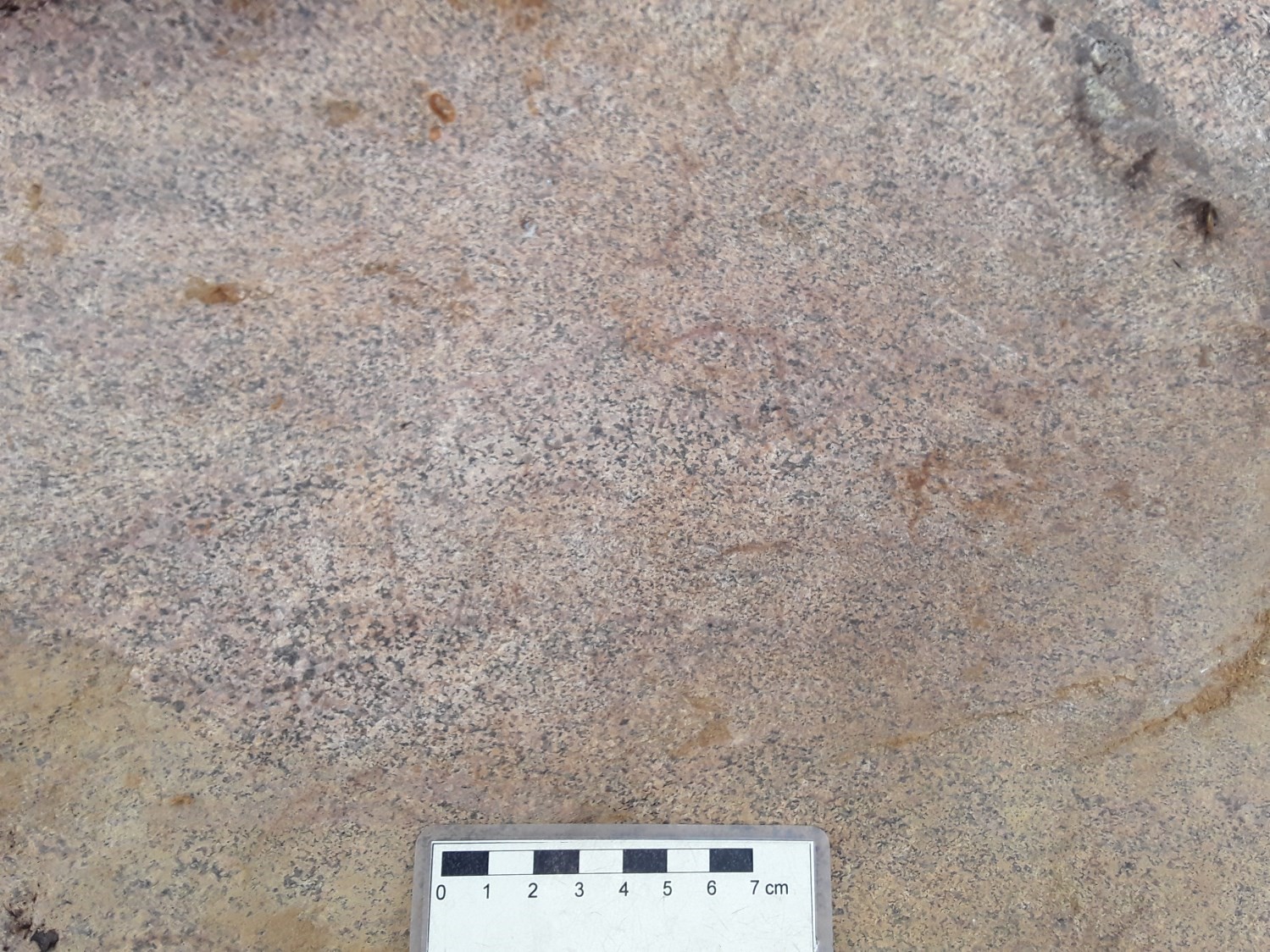
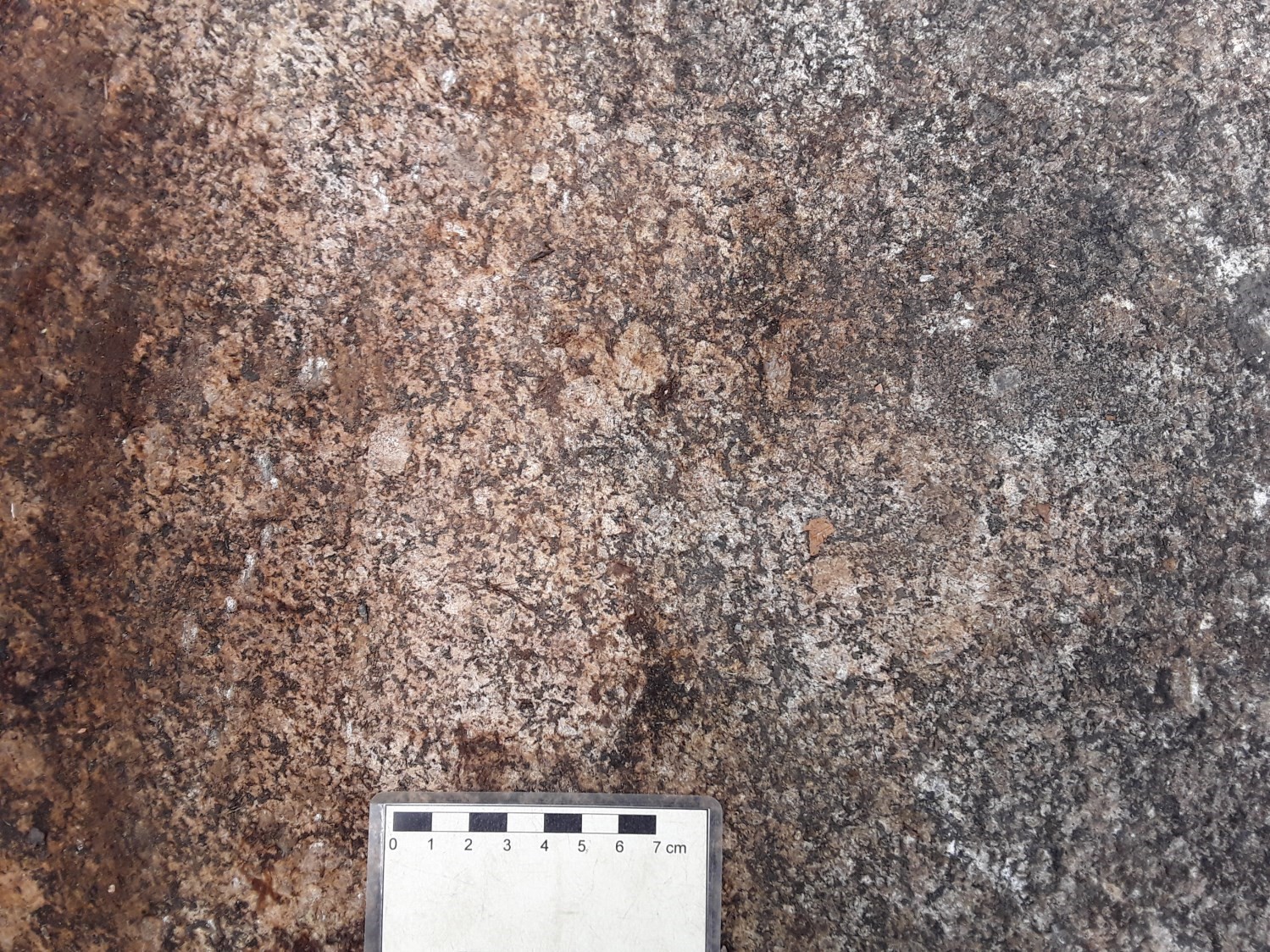 Smaller proportions of syenogranite (e.g. outcrop 2021-FT-3307) and quartz monzodiorite (e.g. outcrop 2021-FT-3079) are mapped in the batholith. The syenogranite is generally pink in alteration patina, pink-grey in fresh surface, equigranular, fine grained and foliated. In outcrop, the mineralogy consists of quartz, feldspars, biotite and magnetite. The quartz monzodiorite is green-brown in alteration patina and grey-green in fresh surface. The rock is medium to coarse grained, porphyroid with feldspar phenocrysts (<5% length, <5% of the rock) and foliated. Its mineralogical composition consists of potassium feldspar, plagioclase, magnetite, clinopyroxene, orthopyroxene and biotite. The accessory phases are apatite and ilmenite.
Smaller proportions of syenogranite (e.g. outcrop 2021-FT-3307) and quartz monzodiorite (e.g. outcrop 2021-FT-3079) are mapped in the batholith. The syenogranite is generally pink in alteration patina, pink-grey in fresh surface, equigranular, fine grained and foliated. In outcrop, the mineralogy consists of quartz, feldspars, biotite and magnetite. The quartz monzodiorite is green-brown in alteration patina and grey-green in fresh surface. The rock is medium to coarse grained, porphyroid with feldspar phenocrysts (<5% length, <5% of the rock) and foliated. Its mineralogical composition consists of potassium feldspar, plagioclase, magnetite, clinopyroxene, orthopyroxene and biotite. The accessory phases are apatite and ilmenite.
Thickness and distribution
The batholith outcrops in the SE corner of sheet 32H07 and continues eastwards into sheet 32H08. It is polyphase in nature and is more or less elliptical with an area of ~200 km².
Dating
None.
Stratigraphic Relationship(s)
The Long Batholith is intrusive in the Vertu Plutonic Suite and the Barrois Complex. It is bounded by a definite fault whose movement is undetermined and is crossed by other faults deduced from geophysical data. In turn, all phases of the batholith are generally cut by granite and granitic pegmatite dykes.
Paleontology
Does not apply.
References
Publications available through SIGÉOM Examine
El BOURKI, M., MOUKHSIL, A., 2021. Géologie de la région de Dolbeau-Blondelas, Province de Grenville, région du Saguenay–Lac-Saint-Jean, Québec, Canada. MERN; BG 2022-02, 1 plan.
INTISSAR, R., BENAHMED, S., 2015. LEVÉ MAGNÉTIQUE AÉROPORTÉ DANS LE SECTEUR OUEST DU LAC-ST-JEAN, PROVINCE DE GRENVILLE. MERN, GOLDAK AIRBORNE SURVEYS; DP 2015-06, 7 pages and 2 plans.
Suggested Citation
Ministère de l’Énergie et des Ressources naturelles (MERN). Long Batholith. Quebec Stratigraphic Lexicon. https://gq.mines.gouv.qc.ca/lexique-stratigraphique/province-de-grenville/batholite-de-long_en [accessed on Day Month Year].
Contributors
|
First publication |
Abdelali Moukhsil, P.Geo., Ph.D. abdelali.moukhsil@mern.gouv.qc.ca; Mhamed El Bourki, GIT, M.Sc. A. mhamed.elbourki@mern.gouv.qc.ca (redaction) Mehdi A. Guemache, P.Geo., Ph.D. (coordination); Fabien Solgadi, P.Geo., Ph.D. (critical review); Simon Auclair, P.Geo., M.Sc. (editing); Catherine Tremblay (English version). |

